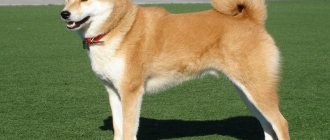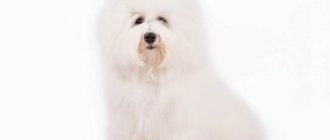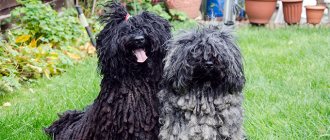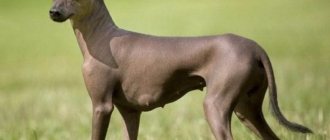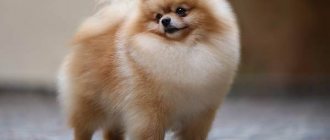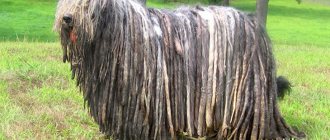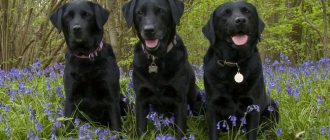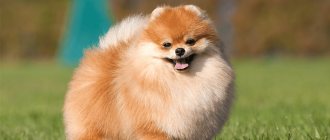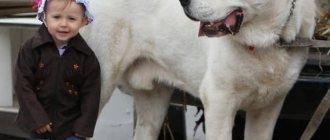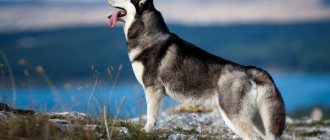Japanese dogs reflect the samurai spirit of the inhabitants of the Land of the Rising Sun. They are reserved, independent, selflessly devoted to their owners and have exceptional fortitude. This small group contains a record number of breeds, whose loyalty and ingenuity were reflected in films and captured in monuments.
Breeds are conventionally divided into two groups: native Japanese and those bred by crossing with foreign relatives. The breeding of the former is controlled by the Association for the Preservation of the Japanese Dog (Nippo). They are also considered national treasures of Japan.
In the review I described all Japanese dog breeds with photographs . You will learn about the similar and different features of the appearance and character of each representative. I also indicated the key points in care, maintenance and education.
Other selections: Russian dog breeds, American dog breeds
Akita Inu
The Akita Inu is the most famous Japanese dog breed, one of six in the Nippo registry. She was made famous by a dog named Hachiko. After the death of the owner, for 9 years he waited for him every day at the station, where he returned after work. A monument was erected to a faithful friend, and two films were made based on the story: a Japanese and an American remake.
The Akita breed originated in the Japanese province of the same name, on the island of Honshu. This is one of the 14 most ancient breeds, whose ancestors accompanied people back in the 2nd millennium BC. e. Initially it was used to catch large animals, today it is kept as a companion.
Akita Inu is the largest Spitz-type dog. Its height reaches 61–67 cm, and its weight is 40–50 kg. The breed is distinguished by its hard, straight coat with abundant undercoat. Acceptable colors are red-fawn, sesame, brindle and white. For all colors, except the last one, the so-called. “urajiro” - light hairs on the sides of the muzzle, chest, body, neck and tail.
You can keep an Akita in an apartment, house or enclosure. Care is simple: the coat is washed 2-4 times a year, combed once a week, and during the molting period - 3-4 times. Difficulties arise only with education and training. Like all Japanese dogs, the breed is stubborn, independent and listens only to those who have earned its respect.
Red dogs.
What does an Asian Shepherd look like (breed standard)
Whether a dog is purebred or not is determined by dog handlers in accordance with FCI standard No. 335, which lists all the basic facts about the Central Asian Shepherd (Alabai) dog breed. The regulations were adopted in 1993 and later supplemented with amendments. According to this document, a typical representative of the genus has the following characteristics:
- Dimensions. The animals are tall and massive, and recently there has been a tendency towards an increase in average size. Thus, in 2010, amendments were officially adopted on the minimum height of individuals: a female is recognized as a purebred with a height at the withers of at least 65 cm (previously 62 cm), and the dog Alabai must be no lower than 70 cm (previously 65 cm). Minimum weight thresholds: 40 kg for females and 50 kg for males. The maximum values are not limited.
- Coat. The guard hair is coarse, straight, hard. The undercoat is thick. According to the nature of the coat, two varieties are distinguished: Alabai short-haired (hair 3-4 cm) and long-haired (hair 7-8 cm long). Individuals of the latter type have feathering on the ears, paws and tail, as well as a fluffy mane.
- Color. It has many variations: from brindle or piebald colors to plain black, gray, fawn or red coat color. Chocolate, liver and blue colors are considered defects.
- Leather. Thick, elastic. It forms a moderate dewlap on the neck, protecting the dog’s throat from injury during a fight with an enemy.
- Ears. Triangular, hanging, low set. They are small, but are often docked (a custom that has been characteristic of this breed of dog since the times of Ancient Asia).
- Head. Large, massive, similar in shape to a rectangle. The skull is flat, long, the occipital protuberance is noticeably pronounced. Stop smoothly.
- Eyes. Brown in color, small, oval in shape. Set wide apart. The superciliary ridges are pronounced, the color of the eyelids in dogs of the Alabai breed is black.
- Muzzle. Medium length, voluminous, without narrowing. The bridge of the nose is straight, the large lobe is in most cases black (less often, deep brown). The lips are thick, powerful, usually black pigmented. The jaws are large and strong, the bite type is scissors, the number of teeth is 42.
- Body type. The neck is heavy, moderately long, with a dewlap. The chest is deep, rather long, slightly widening towards the back. The ribs are rounded, the belly is slightly tucked, the back is straight and muscular. The loin is short, the croup is wide. The standardized characteristics of dogs of the Alabai breed also note a certain high-backedness of individuals.
- Limbs. With strong bones, straight. The paws are shaped like an oval, small in size but powerful.
- Tail. Dense, high-set, but the animal keeps it low. Otherwise, what the tail of an Alabai dog looks like is determined by the preservation of its natural appearance or by docking. The tail is naturally long, often resembling a saber, but sometimes its tip can be wrapped in a ring. The docked tail is short and thick.
According to the official characteristics, the Alabai dog breed received these qualities. But do not forget that Central Asian Shepherds are bred in many regions. Kazakh, Tibetan, Kyrgyz, Turkish Alabay and other types of CAO have the right to have individual characteristics. Therefore, the decision on the pedigree of an individual is made by a special expert commission that evaluates the degree of deviation of the dog’s appearance from specific types of the Alabai breed.
American Akita
The American Akita was bred from the Akita Inu. The first representatives from Japan were brought to the United States after World War II, where they quickly became popular.
To create a new type of dog, Americans crossed Akitas with German shepherds and mastiffs. The resulting breed was called the "Big Japanese Dog". It differs from its eastern relatives in its massive build, variety of colors and more docile character.
Otherwise the breeds are similar. American Akitas are also freedom-loving and independent, like their Japanese relatives. Maintenance and care are also the same: a large Japanese dog is kept in an apartment or outside the city, washed several times a year and combed every week.
Iranian dog breeds
Saluki or Persian Greyhound
The Saluki, like other breeds found in Asia, is one of the oldest dogs in existence. This breed is native to the so-called Cradle of Civilization , a region that is currently Egypt, Iran, Iraq, Israel, Jordan, Lebanon, Palestine and Syria.
Salukis were used to hunt hares and gazelles, and they are also known to have crossed the Silk Road with caravans and nomadic tribes. Currently, they mainly thought that the family dog was a breed who could be a wonderful companion.
Jomon-shiba
Jomon Shiba are the smallest among native dog breeds: height - 32-40 cm, weight - 6-10 kg. Their ancestors accompanied people a thousand years ago, in the so-called. “Jōmon period”: hence the name of this Japanese breed.
Unfortunately, the breed was lost for a long period. Until the Nippo organization began reviving it based on the Shiba Inu in 1928.
The Jomon Shiba has a more “wild” and ferocious appearance than the Shiba Inu. Externally, the dogs are similar to the extinct Japanese wolves. In addition, they are more difficult to train: dogs are stubborn, willful, fearless, and often aggressive towards other dogs and people. They need a special approach and early socialization.
The small size of jomons allows them to be kept in an apartment. But long walks are needed: at least 2–3 hours a day. And the fur sheds a lot, so the fur coat is combed at least twice a week.
On topic: Dogs for keeping in an apartment
Kyrgyz dog breeds
Taigan
Taigan is a Kyrgyz that was originally used for hunting foxes and marmots. They have a medium-length curly coat, but their silhouette is similar to the rest of the greyhound group.
Taigan dogs are good companions, intelligent and adaptable to all types of terrain .
Kai
The Kai (also brindle dog or tora) is another native Japanese dog breed listed in the Nippo registry. This is a medium-sized dog (45–50 cm and 11–25 kg). It is distinguished by black spots on the tongue and brindle color: pure, with a predominance of red or black.
The endurance, agility and courage of the breed allow the Kai Inu to be used as a universal hunter. It copes equally well with any game: from pheasants to bears. But today, Torah is more often taken as a companion.
Brindle dogs are amazing. They become strongly attached to their owner and selflessly protect him, cannot tolerate family changes, and with proper socialization they get along well with other animals and strangers. They are also clean, smart, independent, excellent swimmers and able to climb sloping trees.
Kai is a rare breed even in Japan. No more than 900–1,100 new puppies are registered per year.
Tibetan dog breeds
Tibetan mastiff
The Tibetan Mastiff is silent and large, can reach 85 cm in height, but is a kind dog breed. The monastery type is heavier and larger, while the nomad type is smaller. Tibetan Mastiffs have thick, spongy layers that are heavier around the neck; They also have an inner woolen coat and coarse guard hair.
Kishu
Kishu is another ancient breed from the Land of the Rising Sun, recognized as a national treasure. It has the typical external features of Japanese breeds: a triangular head, pointed erect ears, a curved tail and double coat. The color is most often white, but there are also representatives with a red or zone color.
Kishu is a rare breed. There are not many dogs even in Japan: about 11–13 thousand. And outside the country they are generally difficult to meet.
Despite their average size (49–52 cm), kishu are fearless hunters of large animals. They bravely drive bears and wild boars, hold them until the hunter arrives, jumping onto the back of the prey and clinging to it with their teeth. Pets can also guard the territory or herd livestock.
Kishu are unpretentious and can live in the harshest conditions. They don't care about heat or cold. But minimal care is needed: washing once every couple of months, weekly brushing, brushing teeth and ears, and trimming nails as they grow.
Breeds of white dogs with names and photos.
Thai dog breeds
Thai Bangkai dog
The Thai bangkaew dog is medium sized, intelligent and affectionate, and has a bit of a fox in his personality. They require early socialization. Like many local Asian dog breeds, the Thai Bangkai dog is a Spitz with thick and double coated fur.
Thai Ridgeback
The Thai Ridgeback is a rare breed of local Thai dog that is growing in popularity in its homeland. They are intelligent, protective and resilient; Thai Ridgebacks are famous for being one of the three crested dog breeds in the world...
Thai Ridgebacks are medium sized, with short hair and triangular ears...
Ryukyu
Ryukyu is a medium-sized dog: weight varies from 15 to 20 kg, weight - from 46 to 55 cm. The breed looks intimidating and resembles a wild dog. In fact, they are loyal, affectionate and obedient companions. Although, like all “Japanese”, they are freedom-loving and willful.
Ryukyu love their owner and family very much. But they are wary of strangers, sometimes aggressive. And their hunting instincts do not allow them to get along with other animals.
The breed originated on the Ryukyu island archipelago. It almost disappeared during World War II. Restoration began in the 1980s. But even today representatives are rare: there are only about 1,000 dogs.
The color of the Ryukyu is usually brown, less often brindle with a predominance of red, black or white.
It is better to keep Ryukyu in a country house with a large fenced area. If you keep them in an apartment, you will need daily walks lasting at least 2-3 hours. The rest of the care is simple: weekly brushing, as well as cleaning the ears and teeth.
Vietnamese dog breeds
Phu Quoc Ridgeback
Like the Thai breed, the Phu Quoc Vietnamese Ridgeback is known for being the smallest of the three races that have the hair on their back folded against the direction of the remaining fur...
Phu quoc ridgeback comes in different colors; They are obedient, intelligent and physically stable, so they can learn all sorts of tricks . However, they are a rare breed.
This is our list of Asian dog breeds. Did we miss anything? Tell us in the comments section!
You may also be interested in:
- Types of Retrievers
- Types of Spaniels: Spaniels are bred all over the world.
Sanshu
The Sanshu is another ancient Japanese dog breed that was lost and revived by enthusiasts in the early 20th century. Her ancestors accompanied the emperors, protecting their lives and protecting their peace. And today pets are excellent watchdogs, faithful companions and devoted family members.
Sanshu is a rare breed, almost never found outside of Japan. Also, it has not yet been recognized by major canine organizations.
Sanshu is distinguished by its medium size (41–46 cm and 20–25 kg), a fox face, triangular ears and a tail thrown over the back. The color is varied: white, red, brown, tan, black, gray or pepper and salt.
Sanshu are unpretentious. They can live in a house or apartment, and hygiene procedures require periodic brushing, bathing, and examination of ears and teeth. The main thing is to pay attention to nutrition and disease prevention. If you take proper care of your pet, he will live to be 15–17 years old.
Pakistani dog breeds
Hooligan kutta
Bully kutta is a Pakistani guard dog. Unfortunately, this breed is known for fighting dogs that are illegal. This breed is protective of its owners and is very loyal to the family with which it lives.
If you are thinking about adopting a bully kutta, why not consider a Punjabi name for dogs?
Sakhalin Husky
The Japanese call Sakhalin or Gilyak Laikas Karafuto-ken. Initially, the breed originated in the Amur region and Sakhalin. But in the 30s of the 20th century they were purposefully exterminated in their homeland. At the same time, the dogs were taken to Japan, where they were revived.
Sakhalin Huskies are considered an endangered breed. Work is still underway to restore and increase the number.
Sakhalin residents are sled dogs. They were also used to bait bears and sea animals. They are smart, brave and very resilient. In terms of working qualities, they are superior to Siberian Huskies, Malamutes and other breeds.
The breed went down in history thanks to an amazing incident. In 1958, Japanese researchers had to leave 15 Sakhalin huskies in Antarctica. Scientists expected to pick them up soon, but due to worsening weather they were able to return only a year later. Surprisingly, people found two surviving dogs. In honor of them and the dead dogs, a monument was erected in Japan, and two films were made: “Antarctica” and the American remake “White Captivity”.
How to care for a “teddy” pet
The American Akita is a fairly large dog that will feel more comfortable in a spacious house than in a small city apartment. But despite this, she easily adapts to any conditions. A silent dog will not bother neighbors with its loud barking or whining when its owners are away. And this is another plus for people who are periodically absent from home.
The pet does not require any specific care. But in order for the American Akita to always look neat, you need to adhere to some simple rules:
- bathing - as they become dirty, show dogs are washed before each show; it is worth noting that the coat of American Akitas is capable of self-cleaning;
- nail trimming - as needed;
- cleaning ears and teeth - once every seven days;
- combing the wool - twice a week, during shedding, which happens twice a year - every day.
Training and education of the American Akita
It is necessary to start socializing your pet as soon as he opens his eyes and begins to hear, that is, from two weeks of age. From this moment on, you should accustom the puppy to the voices of people, including loud radios and TVs, to the sounds of the surrounding world: to the buzzing of lawn mowers, to cars. The sooner you start working with your pet, the more successful it will be. Since this breed has Shepherd blood flowing through it, they are easy to train.
It is very important at the very beginning of the education and training process to show the puppy who is really the boss. If this moment is missed, the pet will not obey and follow commands.
The American Akita does not like playing with various kinds of toys; most representatives of this breed are extremely indifferent to treats, which means that the best means of motivation are words of praise, a smile and a good-natured look from the owner.
Show dogs are taught show tricks
Walking with an Akita
To make your pet feel comfortable, he needs hour-long walks twice a day. Akita does not need intense physical exercise, but at the same time it is a fairly hardy dog. She can run 7–10 km behind a bicycle.
It is almost impossible to suppress the hunting habits of a pet. So, during a walk, an Akita can rush at representatives of smaller breeds of dogs, birds and cats. But she is loyal to representatives of her breed. Akita can attack cats and other animals living in the same apartment.
The pet tolerates any weather conditions well. So, in winter he can happily roll around in the snow; in summer, when it’s hot, he can find himself a comfortable place to rest.
The American Akita easily tolerates any weather conditions
What to feed an American Akita
The American Akita is not picky about food. She can happily eat both ready-made store-bought food and homemade food. But it is worth remembering that your pet cannot be fed from a common table. A dog's diet is significantly different from the diet of humans.
The American Akita's diet should be rich in vitamins and nutrients. This especially needs to be taken into account when feeding homemade food. When choosing ready-made food, preference should be given to premium or super-premium products.
The list of prohibited and permitted foods for Akitas is no different from what is suitable for other dogs.
Pet health
Despite the fact that the American Akita has strong immunity and is known for its endurance, the list of diseases to which this breed is predisposed is quite extensive:
- Hip dysplasia. It occurs as a result of increased load on the musculoskeletal system as the pet grows up. If the problem is not detected promptly and treatment is not started, it can cause disability for the pet.
- Volvulus. It occurs as a result of the individual structure of the pet’s digestive system. The problem can be solved surgically if you consult a veterinarian in a timely manner.
- Cushing's syndrome is a disease of the endocrine system, which consists of excessive production of the hormone cortisol, which leads to gastrointestinal disorders, hypertension and a number of other complications. The disease most often occurs in older dogs. Therapy is taking expensive medications.
- Food allergies. It can be difficult to recognize the disease in the early stages due to the thick coat. It is necessary to carefully choose natural food products and buy food designed specifically for animals with allergies. The disease should be treated by a veterinarian. Some pets are allergic to their own fur, which manifests itself during the molting period.
Joint dysplasia manifests itself throughout life in the form of lameness and abnormal gait.
Shiba Inu
The Shiba Inu is the most popular of the six native Japanese breeds. Declared a national treasure in 1936.
Despite its small size (7–13 kg and 36–40 cm), the Shiba Ken is an ancient hunting breed. Her ancestors hunted birds, wild boars, bears, and deer. Today the dog has retained its hunting instinct. But years of selection and popularization have turned the pet into a loving and faithful family member.
However, the Shiba has not lost its inherent “Japanese” features. She is freedom-loving, unobtrusive, reasonable. Her trust and respect must be earned. The Japanese believe that raising a breed is akin to making origami: it must be soft and consistent so as not to spoil the dog’s delicate psyche.
The Shibu Inu has many amazing traits. For their cleanliness and independence, dogs are often compared to cats. But the most unusual feature of the breed is its penchant for contemplation. Dogs can spend hours admiring the flow of the river or the sunset.
The Shiba Ken is usually a red dog. But black and tan, white or zone suits are also found. Grooming is standard: occasional bathing, periodic brushing, teeth and ear cleaning.
Shiba is another legendary dog. A dog of this breed led rescuers to the house of its owners after an earthquake in 2004. The events are depicted in the film “The Story of Marie and Three Puppies.”
Detailed description of the Shiba Inu breed.
Pros and cons of the Asian Shepherd breed
| Positive features | Negative |
| Bravery, fearlessness | Tendency to dominate |
| Guard Skills | Aggression towards strangers |
| Kindness towards household members | Stubborn character |
| Unpretentiousness in content | Requirements for space |
| High intelligence | Need for physical activity |
| Devotion | Professional training required |
Shikoku
Shikoku or Kochi looks like a wolf. And has the same endurance, strength and flexibility. The breed originated in the Middle Ages. It was originally used for hunting wild boar and deer. Today, dogs are also used to catch animals, and also to protect the territory and are simply kept as pets.
The Kochi Inu is another native Japanese breed included in the Nippo registry. In 1938 it was recognized as a national monument. Unfortunately, there are not many Shikoku dogs: there are about 7,000 registered dogs in the country.
Shikoku is a medium-sized dog: 16–26 kg and 49–52 cm. It is distinguished by thick, coarse hair with abundant undercoat and “wild” colors: red, black, brown or sesame. Whitish hairs on the sides are required - urajiro.
Shikoku is perhaps the most docile dog among the native Japanese breeds. She is people-oriented, attached to her owner, and friendly to strangers. She learns easily and loves to work, she is not as stubborn and independent as other “Japanese”. However, it is aggressive towards other animals, so early socialization is needed.
It is better to have a Kochi-ken outside the city. But an apartment is also suitable, provided there are many hours of daily walking. Pets are clean: it is enough to wash them 3-4 times a year and brush them once a week.
Character of Central Asian Shepherds
It’s clear what Asian dogs look like, but how does an Alabai behave next to a person? Is a dog dangerous, which, if it stands up to its full height, will turn into a powerful two-meter colossus? Or is he kind, friendly and will never show aggression without reason? To answer these questions, it is necessary to study the characteristics of the psyche and intelligence of these animals.
Typical qualities and habits
Alabai, like all other Asian dog breeds, is distinguished by its independent, proud oriental character. This dog is always on his own mind, which is why he is decisive, self-confident, and fearless. What distinguishes Asians from clearly aggressive types of dogs is their acquired poise: the dog will never enter into conflict without a good reason.
Nomadic breeders bred a special guard breed of dogs, the Alabai, and not fighting dogs, much less killers. Therefore, anger is a quality that is considered a defect for these individuals. Overly aggressive Asian Shepherds were deliberately shot to achieve a calm and balanced temperament in the breed.
This restraint and a peculiar, truly oriental, detachment from stimuli are the characteristics with which the Alabai stands out among other representatives of the large-sized Canine family. The temperament of Central Asian Shepherds is calm, even mysterious in some ways. At the same time, females have a more dynamic and playful disposition than males.
Gender differences also appear in the security service. When trying to enter the territory of a stranger, the Alabai girl will burst into barking and block the way. Asian dogs have more aggressive behavior: they rush at the enemy with lightning speed, without bothering with warnings.
An Asian Shepherd puppy is always happy to make friends with people. The pet will equally love and protect all family members. A very interesting feature of these dogs is their extraordinary sensitivity to the mood of their owners. The dog will not bother the owners, but will gladly support the game and exchange of affection if the owners are in a good mood.
However, strangers to the Alabai breed remain suspicious. CAO is always on alert with guests, neighbors and passers-by. The slightest provocation from a stranger can cause an aggressive reaction from the pet, so while still a small puppy, the dog must undergo a course of training and proper socialization in society.
Another not the best characteristic of the Alabai breed is its bias towards small animals. An ill-mannered dog can easily break off the leash and chase a cat or small dog. Such situations must be nipped in the bud from the very childhood of the pet.
Perception of training
CAOs are distinguished by a long period of maturation. Individuals develop fully physically and mentally by the age of 3. Moreover, with age, Alabai dog puppies increasingly show a tendency towards dominance: the playful fluffy ball turns into a natural wolfhound and strives in every way to show its leadership. At this time, it is especially impossible to allow an Alabai to put himself on the same level as a person.
The owner must become the unquestioning leader for the Asian Shepherd!
Puppy training begins at two months of age. Classes must be systematic and last at least half an hour. First of all, the pet learns to respond to its nickname, and then all the basic commands are systematically learned. By 7 months, an Alabai dog should understand typical orders: Sit! Place! Ugh! To me! It is forbidden! and so on.
The average Asian Shepherd will not obey easily - its temperament is too capricious and independent. Therefore, when raising a dog you will have to show a lot of patience and ingenuity. Alabai interact very well with incentive training methods. Give your pet a treat after each command, and the dog will remember the benefits of obedient behavior. An affectionate word, praise, a friendly ruffle of the scruff of the neck are also excellent methods to win over the CAO to your side.
Alabai is a herding dog of nomads, and protecting her “herd” or “convoy” is in her blood. Therefore, it is necessary to be careful about the socialization of your pet. The dog should not show excessive wariness towards strangers or rush at relatives. Proper upbringing will turn the CAO into a cute pet, and the absence of strict boundaries will result in the dog’s unpredictability of behavior, because unblocked natural instincts can awaken at any moment.
Tosa Inu
The Tosa Inu or Japanese Mastiff is the only Japanese breed from the Molosser group. She was bred at the end of the 19th century in the province of the same name for dog fighting.
Tosa-ken is a large, powerful dog with well-developed muscles. Weight reaches 40–90 kg, and height – 55–60 cm. The pet is “dressed” in a smooth, close-fitting fur coat of red, apricot, fawn, brindle or black.
The Tosa Inu has mixed blood from Akitas, pit bulls, mastiffs, German pointers and Great Danes. Dogs are strong, agile, fearless. Their advantage and at the same time disadvantage is low sensitivity to pain. Because of this quality, it is not clear for a long time whether the pet is sick.
Today, the Tosu is positioned as a family dog. The pet is balanced, manageable, alert, but not aggressive towards strangers. However, it fiercely defends its territory and owners. It cannot tolerate other animals, especially dogs, and often attacks.
Tosa Inu is a dog for country living. She needs a lot of space and walks at least 1.5–2 hours a day. Short hair is easy to keep clean, but regular hygiene procedures are required: the coat is combed 2-3 times a week and washed monthly.
Weaknesses in the health of the Japanese Spitz
It is worth noting that Japanese Spitz puppies are born healthy with good immunity, but there is a weak point - the eyes. They are born with increased sensitivity to light and there is a risk of developing various eye diseases: cataracts, retinal degeneration, entropion or inversion of the eyelid.
With proper care and systematic examination of the eyes, all this can be avoided, and at the slightest redness or a long walk, wash the eyes with a decoction of chamomile or strong tea.
- Also, the Japanese Spitz has a risk of developing a disease - epilepsy. As a rule, this disease manifests itself before the age of 2 years. If epilepsy is present, the dog is not allowed to breed.
- If the Japanese Spitz eats too often and too much, it can develop volvulus and various other diseases of the digestive system. It is recommended to feed no more than 3 times a day and the amount of food should not be larger than the average palm.
Various types of allergies do not occur.
In adulthood or old age, a Japanese Spitz may develop cancer, especially at risk for those who have had individuals with this disease in their family.
Hokkaido
Previously, Hokkaido was called Ainu-ken by analogy with the indigenous inhabitants of Hokkaido - Ainu. The new name was given to the breed in 1937, when Nippo recognized it as a national treasure.
Hokkaido - medium-sized dogs (20–30 kg and 45–51 cm), used for hunting large animals. Today they are also bred for protection and as companions.
Ainu is a rare breed. You don’t often see them even in Japan, and dogs are almost never taken outside the country. No more than 900 new puppies are registered annually.
Hokkaidos have a typical Japanese breed appearance. They have a compact body, long legs, a tail thrown over the back and an elongated muzzle. The coat is double, with coarse guard hairs and thick undercoat. Color - white, black (pure or with tan), red, brindle, sesame.
Ainu are loyal, obedient and loving companions. But they can be aggressive towards strangers and animals. It is better to keep dogs in a country house with a spacious yard. However, if you walk your pets every day for 2–4 hours, you can have them in an apartment.
Interesting: Loyal dog breeds
How much does a Central Asian Shepherd cost?
The Alabai puppy is evaluated depending on its suitability for the breed. There are three classes of “suitability” of dogs:
- Pet. The individual will not produce purebred offspring, but will be a good guard. The average price is 15,000 rubles.
- Breed. Typical purebred CAO. Estimated at 15,000 – 20,000 rubles.
- Show. Unique purebred Alabai. For such a puppy, breeders will ask for at least 30,000 rubles.
When purchasing a dog, do not forget to check that the documentation is correct.
Japanese Terrier
This breed is the only one of the terrier group bred in Japan. Their breeding began at the beginning of the 20th century. The goal was to get a decorative dog that would easily adapt to life in densely populated cities.
During breeding, Italian Greyhounds, Smooth Fox Terriers, Manchester Terriers and small aboriginal dogs were crossed. The result was a miniature dog (30–33 cm and 2–4 kg), with a compact body, long legs and very short hair (up to 2 mm).
The Japanese Terrier is easily distinguished by its unique tricolor coat. The head is decorated with a black mask with red and white spots, and on the light body there are dark or reddish-brown markings.
The Japanese Terrier is an excellent dog for an apartment and a family. He is friendly, playful, and gets along with children. However, it can chase cats and rodents, and is wary and somewhat cowardly with strangers. The dog is also easy to care for: weekly brushing with a soft brush and occasional washing are enough. The only thing is that the pet cannot stand the cold, so from autumn to spring you will need clothes.
On topic: Varieties of terriers
Indian dog breeds
Mud hound or caravan
The Mudhol dog is a hound from India, where hunting hares and small game is very popular. The Mudhole Hound is believed to be a descendant of the Saluki. It became widely known in the Western world when the state of Mudhol gave one of its royal specimens to King George V of India in the early 20th century...
Greyhound Rampur
This greyhound breed originated in the kingdom of Rampur in northern India. Rampur Greyhounds, with their long, slender legs, are known as ideal dogs to accompany hunts and expeditions in wilderness areas as they are extremely brave. However, their use as hunting dogs is currently prohibited by law.
Rampur greyhounds make excellent companions and pets and are easy to keep because they are affectionate and friendly, although they can be tough with other dogs.
If you are thinking about adopting an Indian dog breed, be sure to give them a local name! Here we have lists of Marathi for dogs and Telugu for pets.
Japanese Chin
The Japanese Chin is another toy dog breed native to Japan. It was bred from Spaniels and Pekingese.
The Japanese Chin is extremely delicate, gentle, loving and courteous. He is completely devoted to his family and gets along well with everyone: from the owner’s children to the cat. Wary with strangers, but not aggressive.
It is vital for Hin to feel part of the family. Dogs that grow up in love and affection are easy to raise. But with a lack of attention or rudeness, pets withdraw into themselves and refuse to obey.
Japanese Chins are intelligent and quickly learn commands. But this is one of the few breeds that is almost not focused on food rewards. Because of this, inexperienced owners have difficulty training.
The coat of Chins is soft, almost does not get dirty and tangle. The color is two- or three-color with red or black spots. A mandatory breed characteristic is a white mark on the muzzle.
Indonesian dog breeds
Kintamani
The Kintamani is a Spitz-type dog native to Indonesia, especially Bali. This native Asian breed is believed to have originated from the domestication of wild local Balinese dogs.
The Kitamani has a white, black, pale or tricolor coat. They are known for their ability to overcome difficult terrain and also have a very independent nature.
Origin story
The Tobets in the form in which they are presented today were formed approximately 3000-4000 years ago. This is evidenced by excavation data and rock paintings discovered on the territory of the Almaty region. It turns out that the Tobet is a representative of one of the oldest breeds, a witness to the entire history and life of the Kazakhs. The first European to describe the Tobets was Marco Polo. He said that these were huge dogs the size of donkeys, very strong and surprisingly friendly. They are used for protection, hunting wild animals and as draft power.
Large male leaders always choose a place on a hill, from where the entire territory can be clearly seen. Hence the name of the breed: “tobe” means hill, “it” means dog, “tobe it-tobet” means a dog on the top, a mountain dog.
The main enemy of livestock in the steppes of Kazakhstan is wolves, and the only salvation from them has always been tobets. In the 20th century, when everything began to be systematized, these wolfhounds were classified as Central Asian shepherd dogs and assimilated with the Alabai. The number of Tobets was also negatively affected by the state of livestock farming, lack of competent breeding work, uncontrolled shooting of dogs and cross breeding. Today, enthusiasts are reviving the breed, pointing out that the Tobet is a national treasure of Kazakhstan that needs to be preserved and increased.
Chow chow
Chow Chows are considered companion dogs. They are very friendly, active, but capricious. This breed should be raised from a very young age, namely from 2-3 months. The Chow Chow needs a moderately strict owner, because if you give him some slack, the animal will feel it and behave as he wants. These dogs are not happy with small children and other pets; they will stay away, but will not offend. Chow chows are very active dogs, because even in ancient times they were used as beaters for deer. There should be at least 2-3 walks in the fresh air per day. Life expectancy is from 9 to 12 years.
Chow chow
Shikoku
Shikoku joins the Akita Inu and Shiba Inu in the group of dogs elevated to the status of Japan's National Treasure. However, unlike the two above-mentioned breeds, Shikoku are much less common. In this regard, acquiring such a pet (if we mean a purebred individual) will be very, very difficult.
Shikoku Inu
Shikoku, like its related breeds, were formed in the vastness of the mountains, which allowed them to develop thick and fluffy wool that protects animals from the cold. The impassable mountainous terrain contributed to better preservation of the Shikoku breed features, which remained unchanged over the centuries.
By the way! The World Canine Association included Shikoku in the list of breeds only in the eighties of the twentieth century.
Character traits
Among the characteristic features that allow us to get a general idea of Shikoku, we list the main ones:
- passionate hunters by nature, Shikoku dogs simply cannot sit in one place for a long time. For them, movement is life. Therefore, it is not recommended to keep representatives of the breed in cramped apartments in an urban environment;
Shikoku Inus love snow and cold climates, but have a harder time adapting to heat.
- The flip side of hunting inclinations is increased aggression towards other animals. Not all individuals exhibit this trait clearly. However, the results of Shikoku's interactions with other dogs or cats are often unpredictable;
- slight excitability does not allow Shikoku to be left alone with small children who do not yet know how to calculate their strength. But representatives of the breed get along well with older children, taking part in their games;
- The watchdog genes predetermined Shikoku's distrust of all strangers. If such a dog believes that its owner is in danger, it will certainly use its sharp fangs to protect its “leader”;
In order to avoid various “emergency situations”, it is important to keep Shikoku on a leash at all times in crowded places.
- Despite their obstinacy, Shikoku are easy to train with the right approach. They are ready to carry out the commands of their owner, if the person himself does not try to suppress the pet and shows respect for him.
Buying puppies
Unfortunately, those people who decide to buy a Shikoku puppy will most likely have to fly to another country. There are no nurseries engaged in breeding this breed on the territory of the Russian Federation. Of course, there are single owners of these individuals, but they do not breed them on a professional level. The closest kennels to Russia that have Shikoku dogs are located in Estonia.
It is very difficult to purchase purebred Shikoku Ino puppies.
Of course, the best option is to travel directly to the homeland of Shikoku. In Japan, puppies of this breed are paid from one hundred to two hundred thousand yen, or from six to twelve thousand dollars.
Sanshu Dog
The Japanese dog Sanshu is a breed of service dog. She was brought out purposefully, wanting to get a small animal for guard duty. The result was a strong, beautiful dog that weighs about 20 kg. Due to its small size and weight, as well as its excellent watchdog qualities, Sanshu can be kept both outside the city and in city apartments.
The color of the animal can be very different, the coat is short and does not require special care. The body is proportional, strong and healthy. Sanshu is perfect to become a companion not only to one, but to all family members. She gets along with other animals in the house and gets along easily with small children. Sanshu has no hunting skills, which guarantees her peaceful interaction even with cats.
History of the origin of the breed
The Chinese Crested dog has been known for a long time - an exotic, graceful and mysterious breed in the world. The dog breed is popular in China and Europe. This is due not only to its attractive appearance. The Chinese Crested is a talisman and symbolizes prosperity.
Representatives of the breed attract glances and attract attention. Dogs have bare skin, large ears, and a fluffy mane.
If you look closely, it resembles a skate in appearance, but has the gracefulness of a deer. If we consider the downy appearance, then the individuals are covered with wool - long and soft. The build is stocky.
The origin story is unknown, everything is shrouded in mystery. As you know, the breed is considered ancient in the world. According to some assumptions, the genus originates from African hairless dogs, which include subtropical Mexican, Egyptian, and Peruvian hairless dogs.
The species was first mentioned 1 thousand years BC. Since dogs personified love, they were treated with reverence and respect. For a long period of time, dogs served as a kind of heating pads.
If we look at the legends, it becomes clear that many aborigines believed that crested dogs were capable of healing people. The Indians still believe that a hairless dog breed can relieve toothache, headaches, rheumatism, and colic.
The breed was first mentioned in 200 BC in China. The best ones were owned by nobles and noble people; dogs symbolized prosperity and good luck.
Since the 16th century, it was customary to take dogs with you on all trips. As you know, the Chinese loved to travel by sea. For this reason, the breed quickly spread to other territories. Thus, the Chinese Crested appeared in America and Spain. Dogs appeared in Britain and France only in the 19th century. However, they were brought from Africa and Asia.
The official date of appearance of the Chinese Crested Dog is 1966. During this period, a cargo of four dogs arrived from China - 1 male, 3 females. British cynologists were involved in selection, breeding and approval. For this reason, the UK is considered to be the country of origin.
